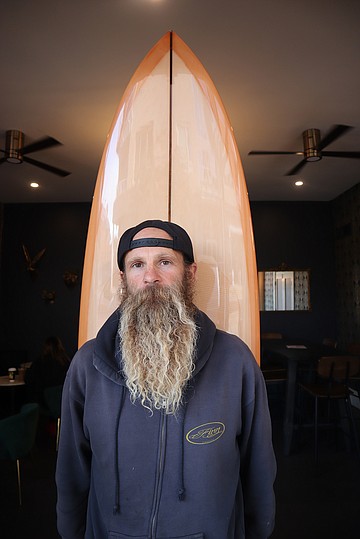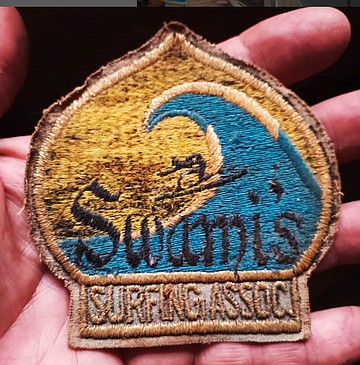Finn Madsen’s FlexWave: the next wave?
“The house was five blocks from the beach. The surf check required walking to the corner and looking down the street.”
Forty-four-year-old Finn Madsen grew up two blocks from where I lived in Cardiff. I would see him around when he was a young man; he rarely spoke to me or anyone else, and I figured — correctly, as it turns out — that he was often stoned. But he wasn’t simply a checked-out pothead. He was smart, but he was self-medicating, numbing the anxiety that seems to plague so many American youth instead of dealing with it.
Later on, I became friends with him while flying little remote-control planes in Cardiff’s Glenn Park. Noting that my plane tended to crash land, Finn taped a dime onto the fuselage in just the right spot, an adjustment that, from then on, allowed me to bring the little plane down for soft landings on the grassy runway. My wayward plane provided the occasion for my first significant conversation with Finn, and I realized he was both a tinkerer and a thinker.
And a builder. As we got to talking, I learned that Finn built everything from beautiful fiberglass canoes to lowrider bikes — but his passion was surfboards. The fascination had been passed down from his dad, Steve, a descendant of one of the oldest families in Cardiff. Steve’s company, California Surfboards, did reasonably well for a few years after its launch in 1962. But the ‘60s surf boom did not bless everyone equally, and within five years, Madsen closed up shop. However, while Steve was over building surfboards, his son was just getting started.

According to Finn, “Some of my earliest memories are of seeing my dad’s unused power planer in our garage and hearing the stories of the surfboards he built with it. At 15, he helped me shape my first board in the garage. I was happy with it, but it was crude in hindsight. Paul Harris, who lived down the street, had a shaping room, and Josh and Joel Tudor always hung out there.” (Joel would go on to become a world champion longboarder.) “We shaped and glassed our boards in Paul’s garage until the fire department shut us down. After that, we’d shape at Paul’s, take the shaped blanks to my house, and glass them in our garage.”
The family connection helped shape Finn’s interest. So did the family home; the old real-estate mantra of “location, location, location” takes on new meaning here. “That house was built in 1919. I moved there when I was 11, and have lived there ever since. The house was five blocks from the beach. The surf check required walking to the corner and looking down the street. Back then, there was nothing between the house and the ocean. We had goat trails running across the tracks, right into the surf. When my grandpa lived there years ago, he would go scuba diving every day, and if my grandma wanted him home, she would hang a red towel on the garage door.”
Today, duplexes and roadways have filled in the space. But way back when, “my mom learned to ride horses up the street from there, in the canyon where the freeway is now. My grandma sometimes rode her horse on the beach from Leucadia to Torrey Pines. I had the tail end of that life, and even as a kid growing up in Cardiff, my best friend and I could walk the train tracks above the lagoon with loaded pellet guns over our shoulders. We were on our way to the bird sanctuary to hunt ducks. Fortunately, we never got any ducks, and nobody said anything or tried to stop us until my grandma came down and pulled us out.”

It sounds idyllic, but “nobody said anything or tried to stop us” has its downside. “By age 17,” recalls Finn, “I began having crazy panic attacks. I had no idea then, but I now realize it was because I was smoking too much pot, drinking every day, and not eating well. I became an automotive machinist at that time, which saved me. I have an engineering and mechanical mind, so that worked for me. I continued building various things and did handyman work, but shaping surfboards was my dream job. After getting sober a few years later, I ran into Dave Daum, the owner of King’s Paddle Sports. He noted how clear-eyed I was. He hired me and showed me how to spray boards with automotive paint. I also began finish shaping for Dave, while also focusing on my own boards.”
“My own boards” here means “custom boards for others.” A custom board is shaped with your height, weight, and surfing ability in mind, and will set you back about $100 a foot. “To build custom surfboards,” explains Finn, “you must understand the person you’re making them for. There’s a lot to consider in making a board: rails, bottom contour, concaves, fins, and outline. One problem in buying a board that is not made for you is that some surfboard models are made for surfers who can surf a table. Whenever I ride a board not built for me, I think, That’s nice, but it’s not my thing.”
What is his thing is still thinking and tinkering, which led to his invention of the FlexPlane. As he writes on his Instagram, “my love for body surfing has pushed my creativity in directions I never imagined…a hybrid crossover between a lunch tray and a hand plane” designed to improve wave-catching and body control. Finn loaned me one on a recent frigid morning, and it allowed me to access areas of a wave that I had never explored in my 60 years as a surfer. It would be presumptuous to call Finn Madsen the new Tom Morey — the surf-tech genius and former Carlsbad resident responsible for the Boogie Board and other soft-board innovations. But it does seem fair to say that he’s carrying on Morey’s spirit of innovation in the pursuit of stoke.